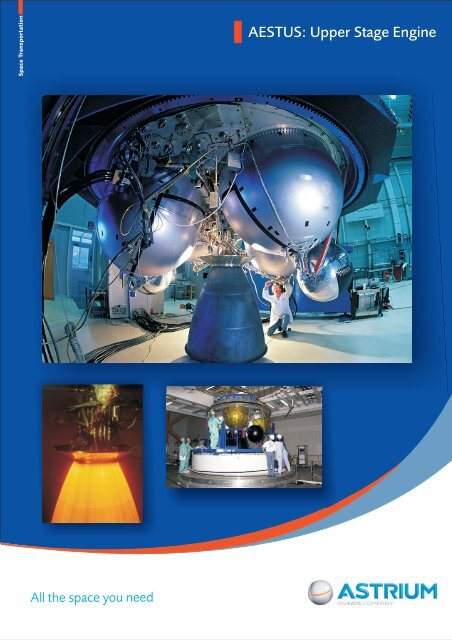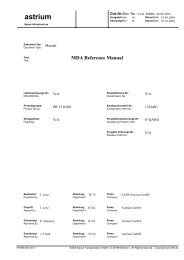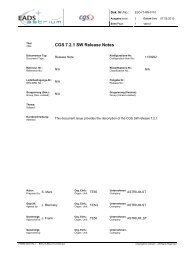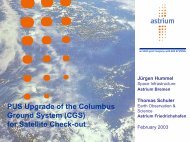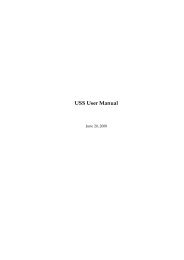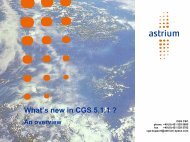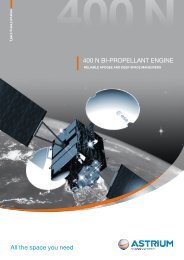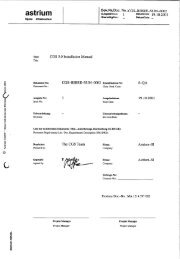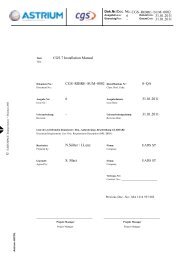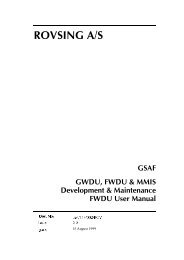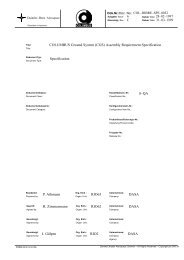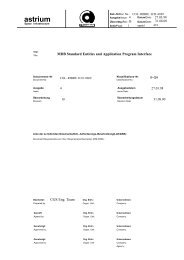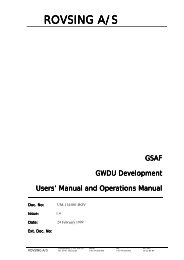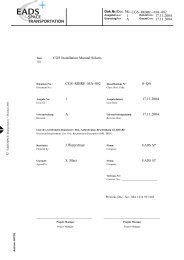AESTUS: Upper Stage Engine - EADS
AESTUS: Upper Stage Engine - EADS
AESTUS: Upper Stage Engine - EADS
Create successful ePaper yourself
Turn your PDF publications into a flip-book with our unique Google optimized e-Paper software.
Space Transportation<br />
All the space you need<br />
<strong>AESTUS</strong>: <strong>Upper</strong> <strong>Stage</strong> <strong>Engine</strong>
Bipropellant upper stage engine for the orbital insertion of heavy payloads<br />
The Aestus rocket engine powers the Operation<br />
Ariane 5 ES and GS version<br />
bipropellant upper stage for the<br />
insertion of payloads into LEO, SSO<br />
and GTO. For the ES version, Aestus<br />
uses its re-ignition capability to place<br />
ESA's 21 tonne Automated Transfer<br />
Vehicle (ATV) into a low Earth orbit.<br />
The Aestus thrust chamber design is<br />
based on the regenerative cooling<br />
principle. Prior to combustion,<br />
MMH fuel is pressurised into a<br />
distribution manifold causing the<br />
fuel to flow through narrow, closely<br />
arranged channels in the<br />
Aestus is a pressure fed engine that combustion chamber wall,<br />
consumes up to 10 tonnes of the configured to cause a highly efficient<br />
bipropellant combination cooling. The MMH then enters the<br />
MMH/N2O4.<br />
injector head which assures uniform<br />
Aestus was developed at the<br />
Ottobrunn Space Propulsion Centre<br />
propellant flow rate distribution over<br />
132 coaxial injection elements.<br />
during the period 1988 - 1995. The The unique design of the injection<br />
first operational flight of Aestus was element as well as the proper<br />
on Ariane 5 flight 502, launched on element distribution along the<br />
30th October 1997.<br />
injector face cause swirl mixing and<br />
Together with the Aestus engine,<br />
<strong>EADS</strong> Astrium is responsible for the<br />
complete Ariane 5/EPS upper stage,<br />
under contract with ESA, with the<br />
atomisation of the propellants<br />
enabling combustion efficiencies in<br />
the chamber in excess of 98% during<br />
the remaining combustion process.<br />
technical advice of CNES.<br />
Upon leaving the injector elements<br />
Major Sub-Assemblies<br />
Injector with coaxial injection<br />
elements for the mixing of<br />
propellants.<br />
and entering the combustion<br />
chamber, the hypergolic propellants<br />
spontaneously ignite and are burned<br />
and accelerated up to sonic<br />
conditions at the throat. The<br />
Combustion chamber<br />
regeneratively cooled by MMH fuel.<br />
Nozzle extension, radiatively<br />
cooled.<br />
Propellant valves for fuel and<br />
oxidiser, pneumatically operated by<br />
pilot valves.<br />
Gimbal joint mounted at the top of<br />
the injector dome.<br />
combustion temperature in the<br />
combustion chamber reaches about<br />
3000 K at a combustion pressure of<br />
11 bar.<br />
Controlling the hot gas wall and<br />
MMH coolant temperature levels<br />
under the high operating<br />
combustion chamber heat fluxes<br />
was one of the most challenging<br />
tasks that had to be overcome during<br />
Electromechanical gimbal<br />
actuators for pitch and yaw engine<br />
control.<br />
Some subassemblies have been<br />
subcontracted to partners including<br />
the gimbal joint to NAMMO Raufoss<br />
(Norway) , the nozzle extension to<br />
Franke AG (Switzerland), the<br />
propellant valves to MOOG<br />
(Germany and USA), the flexible<br />
propellant lines to Witzenmann<br />
(Germany) and the helium filter to<br />
Rellumix (France).<br />
the development phase. A further<br />
challenging task was the<br />
development of a new injector<br />
element for MMH /N2O4, using the<br />
same, highly efficient, coaxial<br />
injection principle used on all of our<br />
cryogenic thrust chambers.<br />
After leaving the combustion<br />
chamber, the final acceleration of<br />
hot gases up to supersonic velocities<br />
is achieved by gas expansion in the<br />
radiatively cooled nozzle extension,<br />
thereby developing thrust.<br />
<strong>AESTUS</strong>: <strong>Upper</strong> <strong>Stage</strong> <strong>Engine</strong><br />
Aestus/Ariane 5 upper stage engine<br />
EPS/Ariane 5 <strong>Upper</strong> stage<br />
with Aestus engine
Proven Design and Performance<br />
Flexibility<br />
The Aestus rocket engine has proven<br />
to be a robust and flexible design,<br />
evolving harmoniously with the<br />
evolution of Ariane 5 and its various<br />
missions, as shown in the Aestus<br />
Development History below.<br />
In addition, by varying the number of<br />
coaxial injector elements, the basic<br />
Aestus design can be used for higher,<br />
or lower thrust applications.<br />
A turbopump engine demonstrator<br />
version,<br />
known as the RS 72/Aestus<br />
2, was<br />
derived from the Aestus<br />
engine. This so called Pathfinder<br />
engine has been hot-fire tested in<br />
cooperation with Boeing Rocketdyne<br />
(Pratt & Whitney).<br />
Aestus Development History<br />
The Aestus rocket engine was<br />
developed at the Ottobrunn Space<br />
Propulsion Centre during the period<br />
1988 - 1995. The first flight with<br />
Aestus under operation was on<br />
Ariane 5 flight 502, launched on 30th<br />
October 1997.<br />
In the frame of performance<br />
improvements to the complete upper<br />
stage, a delta-qualification<br />
programme was performed in 1999 -<br />
2002. Here, the propellant mixture<br />
ratio of Aestus was adjusted from<br />
2.05 to 1.9. Subsequently, the first<br />
operational flight of the performance<br />
enhanced Aestus was on Ariane 5<br />
flight 518, launched on 26 February<br />
2004.<br />
During the period 2003 - 2007, the<br />
Aestus engine underwent a reignition<br />
qualification programme in<br />
readiness for the first launch of the<br />
Automated Transfer Vehicle. The inorbit<br />
re-ignition capability of Aestus<br />
was subsequently demonstrated<br />
during the first launch of ATV<br />
aboard Ariane 5 flight 528, launched<br />
on 9 March 2008.<br />
During ATV mission, the first Aestus<br />
ignition occurs immediately after<br />
separation of the upper stage<br />
composite from the cryogenic main<br />
stage. At the end of the first burn, a<br />
ballistic phase commences for about<br />
45 minutes. A second ignition then<br />
provides a short duration burn for<br />
injecting the ATV into its target Low<br />
Earth Orbit after separation from the<br />
upper stage. A third and final<br />
ignition is then used to de-orbit the<br />
depleted upper stage into a safe reentry<br />
trajectory for burn-up in the<br />
upper atmosphere.<br />
With its proven flexibility and<br />
multiple re-ignition capabilities, the<br />
Aestus engine enables a<br />
considerable range of mission<br />
specific profiles for the Ariane 5<br />
launcher. Ariane 5 ES (with Aestus)<br />
is a suitable launcher also for low<br />
earth operation missions, e.g.<br />
Galileo.<br />
Propellants<br />
N2O 4\MMH<br />
Specific impulse vacuum<br />
324 s<br />
Thrust vacuum<br />
29.6 kN<br />
Propellant mass flow rate 9.3 kg/s<br />
Mixture ratio (TC)<br />
1.9<br />
<strong>Engine</strong> feed pressure 17.7 bar<br />
Combustion chamber pressure<br />
11 bar<br />
Nozzle area ratio<br />
84<br />
Nozzle exit diameter<br />
1.31 m<br />
Overall engine length<br />
2.2 m<br />
Thrust chamber mass<br />
111 kg<br />
Nominal single firing 1100 s<br />
Power 43,700 kW<br />
59,400 hp<br />
Re-ignition capability Multiple<br />
<strong>AESTUS</strong>: <strong>Upper</strong> <strong>Stage</strong> <strong>Engine</strong><br />
Assembled Thrust Chamber of the<br />
Aestus engine<br />
Vacuum Test Platform P4.2 of<br />
Aestus at DLR, Lampoldhausen
ASTRIUM Space Transportation<br />
Propulsion & Equipment<br />
D 81663 Munich, Germany<br />
Phone: +49 89 607 32480<br />
Fax: +49 89 607 85480<br />
Hartwig.Ellerbrock@astrium.eads.net<br />
www.space-propulsion.com<br />
www.astrium.eads.net<br />
Thanks to DLR and ESA for their information and pictures


